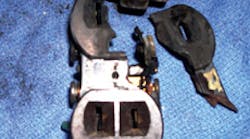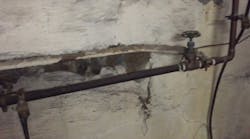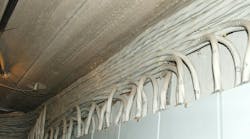As usual, never consider the following commentary associated with these photos as a formal interpretation of the National Electrical Code (NEC). Without criticizing anyone or any product, the following scenarios present us with serious safety questions.
THE RIGGED RECEPTACLE
Randy Barnett, senior instructor, American Trainco, Engelwood, Colo., sent us this photo of what was left of a receptacle that was installed in a large Midwest hospital. The maintenance technician, who brought the receptacle to one of Barnett's training classes, said after he plugged in his vacuum cleaner and turned it on, the receptacle immediately exploded. Investigation by the hospital's electric shop revealed that the receptacle had been improperly connected to a 480V circuit. Luckily for him the vacuum wasn't on when he plugged into the receptacle.
You might ask yourself, How could a 120V receptacle be wired into a 480V system? During a recent remodeling project at the hospital, a contract electrician needed some temporary 480V power, so he rigged a 120V receptacle to get the job done. One can only wonder how he modified the plug he was using at the time. When asked about the situation, he said he simply forgot to disconnect it after he was done with his project. Aside from the fact that the installation violates the Code's requirements that prohibit the use of equipment for a purpose for which it's neither suitable nor listed (110.3), the issue raises questions about whether any such electrician could be considered qualified.
DOCKSIDE DISASTER
Bob Froehlich, vice president, Advance Electric, Robbinsville, N.J., received a call from a local township to visit a public marina that was requesting additional dockside outdoor marine-style pedestals that contain power receptacles for docked watercraft slips. The following note describes the conditions he found during his inspections:
“In my 26 years of experience I've viewed many commercial and industrial electrical installations and as-found conditions, but this installation of electrical work had me totally flabbergasted. The number of violations I took visual note of was beyond my imagination. This installation was so bad, I never asked the owner to unlock the outdoor post-mounted load center because I didn't want to see inside.”
The wiring methods shown in this photo violate many rules found in Article 334 and Article 555 of the Code. The exposed Romex that runs along the edge of the dock is only the tip of the iceberg.
WHERE'S THE METER?
A. K. Rosenhan, P.E., chief engineer for the State of Mississippi in Mississippi State, Miss., received this photo from a rural fire department in the state with the following note:
“Occasionally we see stuff like this, cheating the power company. In this case the house looked to be abandoned and uninhabitable, but when we got the fire put out and looked around a bit this is what we saw. The initial size up was no electrical hookup, not only the jumped meter, but the line back to the transformer was buried in debris from a partial collapse (prior to the fire) of the rear of the house.”
Not only is the theft of electricity illegal, but this installation could also be cited for not meeting the requirements of 110.2, 110.3, or 110.4 of the NEC.
Found a Code violation? Send your photos to Joe Tedesco at P.O. Box 130408, Boston, MA 02113 or [email protected].






